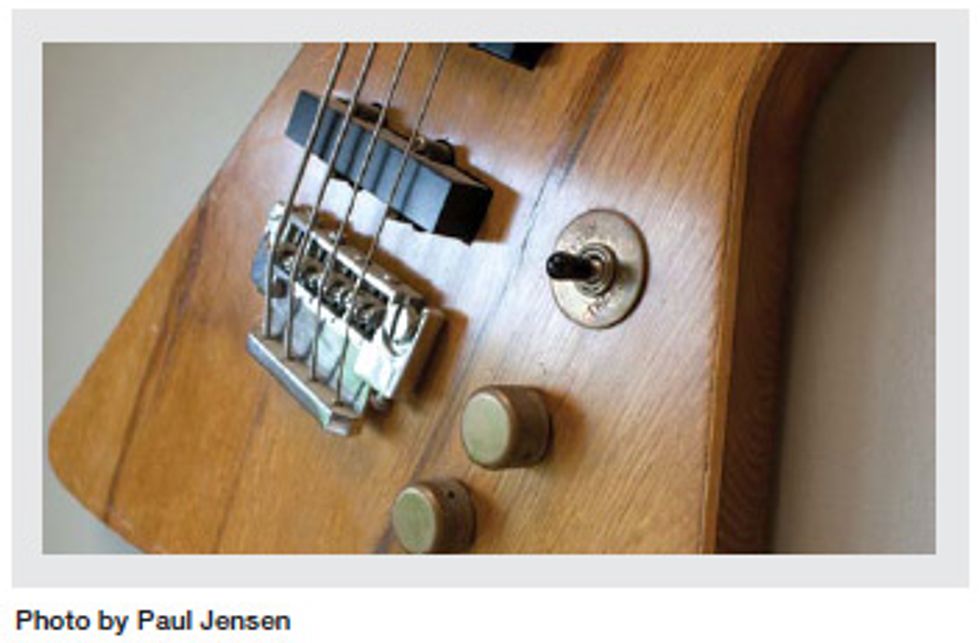I admit it—I have a strange fascination for cheap bass decorations on my wall.
I admit it—I have a strange
fascination for cheap decorations
on my wall. It all started
when I was pricing a framed art
print for my office, and found
out just how expensive it was to
decorate with conventional art.
About the same time, I’d
stumbled upon an odd Explorer-style
electric bass—more like a
pile of parts, really—in a local
shop. I paid all of $15 for it, tried
to fix it up and gig with it, but
it was a hopeless instrument and
best relegated to becoming a wall
hanger. That’s when it hit me
that basses can be art, too. My
office walls now sport four basses,
plus a framed print (of a bassist,
of course). Here’s the rundown.

Wall Hanger #1: The Explorer Boat Anchor (pictured above). When the fire department rescued this bass from an abandoned house, it was painted yellow with black electrical tape stripes. The neck plate is stamped “Japan,” and despite the short, 30.5" scale, it is the heaviest bass I have ever hoisted—about 15 pounds.
When I stripped the yellow finish, I found an ugly piece of wood with a couple of big knots and bark-like lines running through the top. Despite the cheap wood, its makers spared no expense when it came to hardware. It has a hefty and complicated Schaller chrome bridge with a flat plate that slides into a slot on the back. The three control knobs are solid brass, as is the switch-plate ring, which is labeled “Rhythm” and “Treble.”
The neck is set up with a brass nut and super-fat frets, and there are three inlaid position dots at the octave, as if two weren’t enough. Using this bass as art is what it truly deserves, as long as it doesn’t fall down some day and break something.
Wall Hanger #2: A Box of Univox. A few months later, the same shop was bestowed with a box of Univox parts that could conceivably make one whole Univox Coily bass. In case you’re not familiar with the Coily, this model resembles an ES-335 except that it’s fully hollow. Ironically, one of the humbucker’s coils had unraveled and I didn’t think it was worth getting it rewound. I recall paying $40 for this one.
The Coily was made in Japan through the mid ’80s. Both the body and neck are bound, and Univox took an unusual approach to position markers by sliding them up and placing them between the E and A strings. The two octave dots are paired closely together, so that the second dot sits between the A and D strings. Of all the clunker basses I’ve owned, this is the one I wished actually played better and had two working pickups.
Wall Hanger #3: The Eagle- Has-Not-Flown Bass. A few years ago, I was strolling through a local music shop’s clearance sale and spotted what appeared to be a P-bass clone at first glance. And happily, it actually had a chipboard case that latched.
The light-maple headstock bore a scrunched-up, thickly scrawled gold logo that read “Eagle”—I think. A quick web search revealed that there is a Norwegian company putting out guitars and basses under the Eagle brand, and they’re made in Korea—just like my wall hanger.
The plywood body on my Eagle has a sunburst finish, with a chrome bridge ashtray that’s reminiscent of an old P bass’. Holes in the pickguard suggest it once wore a chrome pickup cover, as well. However, its humbucking pickup strays from P-bass conventions and, sadly, only the left half of it works. The neck is a rough grade of maple with a grain pattern that could be considered unconventional, though not in a good way. If you like doing neck whammies, this is the bass for you—but to call it limber would be too kind. At least all the position dots are in conventional locations.
Unlike my other wall hangers, this bass has enough faults that it has never seen a single gig or rehearsal—this Eagle has not flown on my watch! But for the princely sum of $10 (case included), it was all mine. Once again, I think the best place for a bass of this caliber is—you guessed it—on the wall.
Wall Hanger #4: Nearly a Höfner. Once the Fab Four hit the scene, faux Höfners were everywhere. Some of them even had the same design details. Not mine, though. This non-fabulous fake bears nary a single letter on the headstock, and it’s most likely a ’60s or ’70s Japanese clone. An authentic Höfner never had f-holes (mine has one), and they always had a white control plate with a few switches (mine has neither).
I got it from a friend of a friend, whose friend had recently died. When I saw it, I immediately thought “wall hanger,” although I wasn’t really using that term yet. He asked how much it was worth to me and I told him $50, because I planned to use it for another cheap decoration. He caught my drift and countered, “A wall hanger, huh?” The bass even came with a cool, brown, semi-formfitting chipboard case.
Clearly, the neck of this bass is its most astounding feature. You may have heard of the term “hippie sandwich” to describe a neck made of several pieces of contrasting wood. My no-name beats the conventional hippie sandwich hands down—this neck is made of about 30 layers of skinny plies that can be seen easily from the backside. Adding a classy touch that’s common on most of these Japanese copies, the body, f-holes, and neck all have full cream binding, and the fretboard bears pearl block markers with rounded corners.
I’m starting to wonder if I’m the only one with this strange fascination for cheap decorations. These four dysfunctional basses cost me a total of $115. Given the choice between yet another framed print and a bunch of basses, I think I made a good decision to surround myself each workday with the instrument I play.
 Dan Berkowitz
is a professor by day and
a bassist when the sun
goes down. He plays
upright and electric bass
for blues, jazz, orchestra,
and musical theater.
Contact him at profdanb@gmail.com.
Dan Berkowitz
is a professor by day and
a bassist when the sun
goes down. He plays
upright and electric bass
for blues, jazz, orchestra,
and musical theater.
Contact him at profdanb@gmail.com.